In a previous post, I talked about the use of the Harries technique and its suitability for use with the big Maglite 2 or 3 D and others similar flashlights.
See this link:
http://thefiringline.com/forums/showthread.php?t=179342
I am going to explain how to employ the other useful techniques of using a flashlight with a pistol, especially useful for those flashlights that have a tactical switch.
As many of the members already have a Surefire of two or three batteries with a tactical switch or a similar one of another brand, going from 60 to 200 lumens, I am going to explain the two most popular techniques. One is the Harries which I have already explained in the previous post in using with my BOREALIS 1050 lumens light.
Michael Harries invented this position and it is considered one of the first positions ever that coordinates the use of the flashlight using the two hands.
For using with tactical switch lights (with a switch in the tail), the flashlight is grasped with the left hand around the body and the thumb will activate the switch.
The back of the hands are pressed together and maintain an isometric tension to help control the recoil of the gun. Your wrists will be crossed and the light will be parallel or close to the muzzle of the gun.
THE HARRIES TECHNIQUE
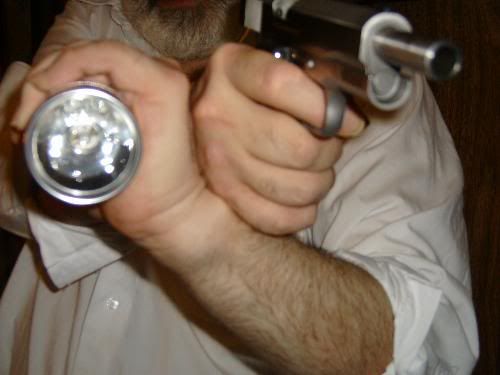
The Roger-Surefire
Holster maker, ex FBI agent, and competition shooter Bill Rogers teamed up with Surefire to adapt a rubber grommet or washer to the Surefire 6 Z (now available in most combat models of Surefire and copied by others light makers).
The position is also called the cigar position, as you grasp the body of the flashlight like a cigar, with the index and middle finger. The tail cap is resting on the fleshy part below your thumb and a little pressure back on the rubber ring will activate the light (the tail cap button resting in that part below your thumb will switch the light on).
That position will let you grasp the hand shooting the pistol with three fingers of the left hand, and it is the only position that let you use a two-handed grip.
THE ROGERS-SUREFIRE GRIP
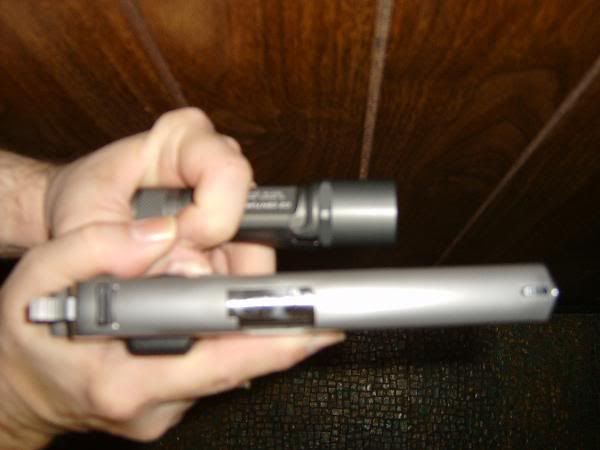
The Chapman technique
Ray Chapman was the first IPSC world champion. He invented his position for use with the Kel-Lites of the 1970’s (probably the first high quality Police Flashlight) that have a sliding switch on top of the barrel. It is still a great position to use for those that don’t want to cross the wrists as in the Harries position when using a big flashlight.
It is well suited for the Maglites and for the modification of the Maglite like my own BOREALIS 1050 lumens.
You just grasp the flashlight as you usually do, with your thumb in the switch and your fingers circling the barrel and you bring it up to index your fingernails with the fingernails of the shooting hand.
THE CHAPMAN GRIP
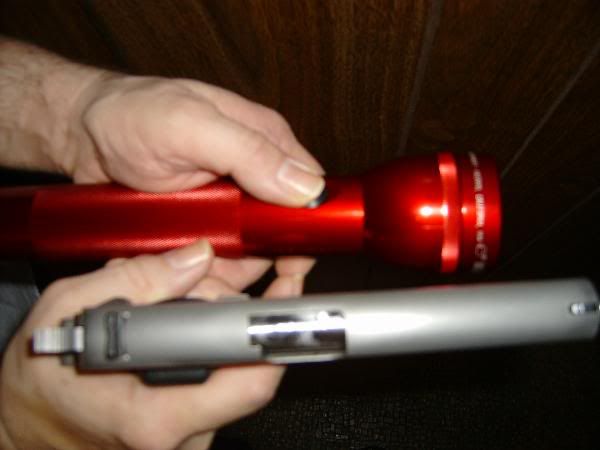
And for last a very useful technique called the REVERSE HARRIES that my friend Middlebrook show me recently.
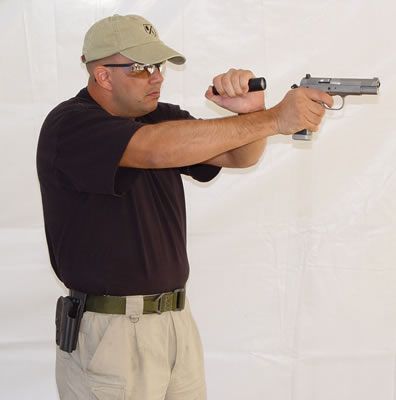
In my other post I have mentioned the old FBI technique which is to separate the flashlight high and away from you in order to confuse you opponent about your position.
Another technique that doesn’t offer any support to the shooting hand but it can be very useful when using a pistol with lousy sights (original 1911, Luger, etc) is the one I used more than 40 years ago when I started combat shooting.
It indexes the light on top of my head, letting the light fall on a line from the sights to the target. Even the minuscule back up .380 or the Baby Browning sights gets illuminated using this ridiculous position.
In closing, I would like to say that in my opinion lights with less than 60 lumens are out of the new low light fighting techniques.
For my belt light I will prefer to have a minimum of 200 lumens, using the Surefire C-3 and the P-91 lamp as my favorite.
But if I have to clear a room I prefer a light with more power. My Surefire M-6 with the 500 lumens lamp will do, but I prefer even more lumens to really blind, disorient, and roast my opponent. That is when I use the BOREALIS 1050 lumens light.
I want to show you some pictures that illustrate the amount of lumens you are putting out when using a Surefire Centurion 2 with the 60 lumen lamp, the Surefire M-6 with the 500 lumens, and the BOREALIS 1050 lumens.
THE SUREFIRE CENTURION C-2 (65 LUMENS)
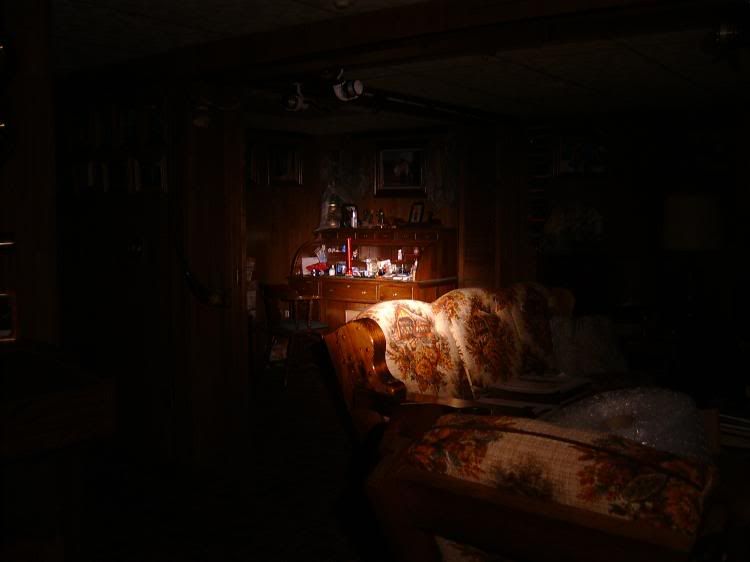
THE SUREFIRE M-6 500 LUMENS)
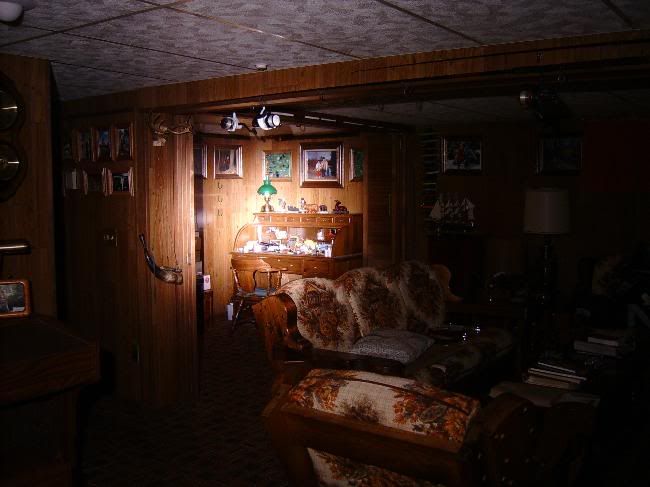
THE BOREALIS 1050 LUMENS
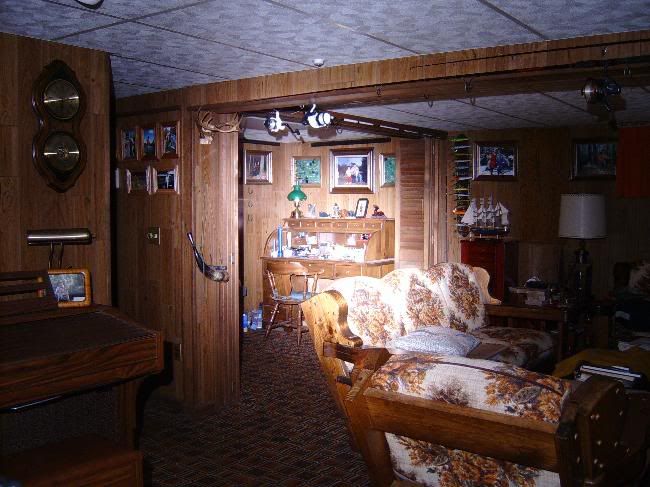
BEST REGARDS
black bear
See this link:
http://thefiringline.com/forums/showthread.php?t=179342
I am going to explain how to employ the other useful techniques of using a flashlight with a pistol, especially useful for those flashlights that have a tactical switch.
As many of the members already have a Surefire of two or three batteries with a tactical switch or a similar one of another brand, going from 60 to 200 lumens, I am going to explain the two most popular techniques. One is the Harries which I have already explained in the previous post in using with my BOREALIS 1050 lumens light.
Michael Harries invented this position and it is considered one of the first positions ever that coordinates the use of the flashlight using the two hands.
For using with tactical switch lights (with a switch in the tail), the flashlight is grasped with the left hand around the body and the thumb will activate the switch.
The back of the hands are pressed together and maintain an isometric tension to help control the recoil of the gun. Your wrists will be crossed and the light will be parallel or close to the muzzle of the gun.
THE HARRIES TECHNIQUE

The Roger-Surefire
Holster maker, ex FBI agent, and competition shooter Bill Rogers teamed up with Surefire to adapt a rubber grommet or washer to the Surefire 6 Z (now available in most combat models of Surefire and copied by others light makers).
The position is also called the cigar position, as you grasp the body of the flashlight like a cigar, with the index and middle finger. The tail cap is resting on the fleshy part below your thumb and a little pressure back on the rubber ring will activate the light (the tail cap button resting in that part below your thumb will switch the light on).
That position will let you grasp the hand shooting the pistol with three fingers of the left hand, and it is the only position that let you use a two-handed grip.
THE ROGERS-SUREFIRE GRIP

The Chapman technique
Ray Chapman was the first IPSC world champion. He invented his position for use with the Kel-Lites of the 1970’s (probably the first high quality Police Flashlight) that have a sliding switch on top of the barrel. It is still a great position to use for those that don’t want to cross the wrists as in the Harries position when using a big flashlight.
It is well suited for the Maglites and for the modification of the Maglite like my own BOREALIS 1050 lumens.
You just grasp the flashlight as you usually do, with your thumb in the switch and your fingers circling the barrel and you bring it up to index your fingernails with the fingernails of the shooting hand.
THE CHAPMAN GRIP

And for last a very useful technique called the REVERSE HARRIES that my friend Middlebrook show me recently.

In my other post I have mentioned the old FBI technique which is to separate the flashlight high and away from you in order to confuse you opponent about your position.
Another technique that doesn’t offer any support to the shooting hand but it can be very useful when using a pistol with lousy sights (original 1911, Luger, etc) is the one I used more than 40 years ago when I started combat shooting.
It indexes the light on top of my head, letting the light fall on a line from the sights to the target. Even the minuscule back up .380 or the Baby Browning sights gets illuminated using this ridiculous position.
In closing, I would like to say that in my opinion lights with less than 60 lumens are out of the new low light fighting techniques.
For my belt light I will prefer to have a minimum of 200 lumens, using the Surefire C-3 and the P-91 lamp as my favorite.
But if I have to clear a room I prefer a light with more power. My Surefire M-6 with the 500 lumens lamp will do, but I prefer even more lumens to really blind, disorient, and roast my opponent. That is when I use the BOREALIS 1050 lumens light.
I want to show you some pictures that illustrate the amount of lumens you are putting out when using a Surefire Centurion 2 with the 60 lumen lamp, the Surefire M-6 with the 500 lumens, and the BOREALIS 1050 lumens.
THE SUREFIRE CENTURION C-2 (65 LUMENS)

THE SUREFIRE M-6 500 LUMENS)

THE BOREALIS 1050 LUMENS

BEST REGARDS
black bear
